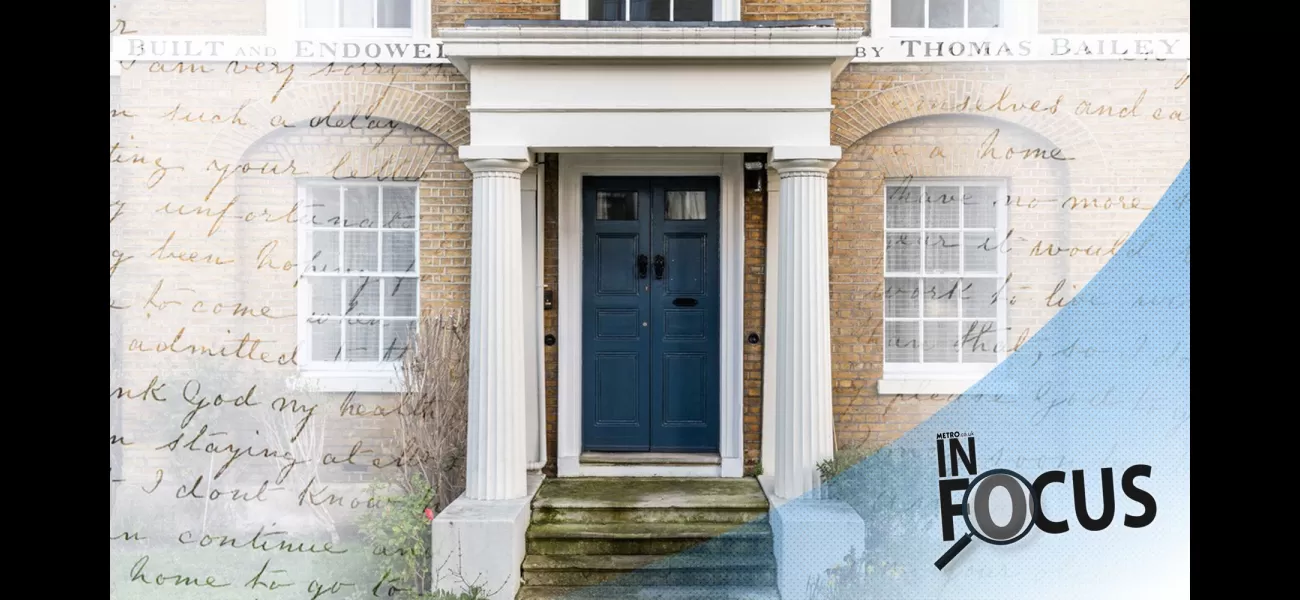London's blue doors conceal an asylum from the 1800s, adding to their air of mystery.
Historic building on Acre Lane in Brixton with an interesting past.
April 12th 2024.

Renowned photographer, Jim Grover, has taken on the task of documenting the intriguing history behind the Trinity Homes Almshouse. For years, Jim had been curious about what was hidden behind the blue doors of the bustling Acre Lane in London's Brixton area. Although the doors were always closed, he couldn't help but notice the flickering lights and fleeting shadows that hinted at some form of activity within. As a social documentary photographer, Jim's interest was piqued and he began to research almshouses, which are charitable homes for those in need, in the area. These homes, originally referred to as hospitals or bede houses, have been around since medieval times.
As Jim delved deeper into his research, he discovered that the building with the blue doors was indeed an almshouse. Fueled by his curiosity, he made it his mission to find a way to enter the building and take a closer look inside. He poured over archives and pieced together the history of the almshouse, which provided him with his first clue - the words "THOMAS BAILEY" in old lettering above one of the windows, and "TRINITY HOMES" emblazoned above another. Jim, who currently resides in Clapham, shared his excitement about finally having the opportunity to explore an almshouse.
The Trinity Asylum, one of three almshouses in Brixton, is located on the busy Acre Lane. It was originally established for "pious aged women" and should not be mistaken for a mental asylum. Jim's interest was piqued even further, as he wondered about the unique community that must exist within the walls of the almshouse and how one could become a resident.
Through his "detective work", Jim discovered that the almshouse was built in 1822, and two years later, Thomas Bailey, a Brixton resident, donated £2,000 (equivalent to around £275,000 today) to the cause. The building, which now has 18 rooms, has multiple entrances, all with blue doors. Thomas Bailey was not only a successful china and glass merchant, but also a devout believer in God. He named the almshouse the "Trinity Asylum", although it was not intended for the mentally ill, as many may assume. Instead, it was a sanctuary for elderly women who were devout in their religious faith.
The criteria for admission into the almshouse were strict. Applicants had to have a small income, provide references that proved their religious beliefs, be single, and most importantly, be between the ages of 57 and 67. One of the residents, Margaret Wright, had fallen on hard times and had been living on a meager £25 per year (less than £4,000 in today's money) in Faversham, Kent. With nowhere else to turn, the 61-year-old begged for a place at the Trinity Asylum.
In a letter from 1879, Margaret wrote, "I have no home to go to. I have no relations except my sisters who are in great need themselves and cannot give me a home. I do hope it might please God to grant that I may soon be admitted to the asylum." She lived in Apartment 15 for 31 years until her passing at the age of 92 in 1914.
Today, the Trinity Homes almshouse continues to provide housing for women in need, although in 1996, they expanded their reach to include men as well. The facility is run by a live-in warden, Andrew Taylor, and currently houses 17 residents and one cat.
Jim was able to connect with a trustee and, over several months, got to know some of the residents. He listened to their stories and gathered photographs for a new exhibition, which will be held at the Lambeth Archives from April 19 to June 1. Jim expressed his admiration for the residents, who are in their seventies and eighties, and continue to lead fulfilling lives and make a positive impact in their community. He believes that everyone's life is extraordinary, and it is his role as a documentary photographer to bring out the extraordinary aspects of each individual and make them proud of their achievements.
One of the residents, Christine Holding, retired from full-time work at the age of 72 and is about to start volunteering at her local GP surgery. Her mother had been a resident at Trinity Homes for 20 years. Christine shared, "I've worked all my life – 42 years. I've got to be doing something... I love meeting people." Jim also had the opportunity to speak with 78-year-old Guy Hunting, a former footman at Buckingham Palace, and 84-year-old Peter Avery, the first male resident of Trinity Homes. Guy shared, "People aren't here by choice, some are here for unfortunate reasons – by 'force majeure'. But some are great fun."
The concept of an almshouse may seem like something out of a Dickens novel rather than a modern-day fixture, but with soaring rents and the challenges faced by young people in becoming first-time buyers, they have become a viable option for those struggling to make ends meet. Jim believes that almshouses could be one solution to the social housing crisis and have been described as the unsung heroes of UK social housing. There are currently around 2000 almshouses in the country, with two new ones recently built in South London. Jim hopes to shed light on their important role and how they operate.
Trinity Homes is now a registered charity and is administered by a group of voluntary trustees. The buildings are also listed as Grade II. In Jim's words, "I want people to understand what they can offer in society right now, where housing and poverty are real issues for many people." The almshouse has been an integral part of Brixton's history for 200 years, yet its hidden history remains unknown to many. Jim's upcoming exhibition, "Behind the Blue Doors", aims to change that. It will feature photographs, archive materials, and stories collected by Jim. His ultimate goal is to make the unseen seen and for people to learn more about the amazing residents of Trinity Homes and be inspired by their rich and fulfilling lives. The exhibition will run from April 19 to June 1, 2024, at the Lambeth Archives in Brixton, and a selection of content will also be available on Jim's website. He will also be releasing a new book for those unable to visit the exhibition in person. To find out more, click here.
As Jim delved deeper into his research, he discovered that the building with the blue doors was indeed an almshouse. Fueled by his curiosity, he made it his mission to find a way to enter the building and take a closer look inside. He poured over archives and pieced together the history of the almshouse, which provided him with his first clue - the words "THOMAS BAILEY" in old lettering above one of the windows, and "TRINITY HOMES" emblazoned above another. Jim, who currently resides in Clapham, shared his excitement about finally having the opportunity to explore an almshouse.
The Trinity Asylum, one of three almshouses in Brixton, is located on the busy Acre Lane. It was originally established for "pious aged women" and should not be mistaken for a mental asylum. Jim's interest was piqued even further, as he wondered about the unique community that must exist within the walls of the almshouse and how one could become a resident.
Through his "detective work", Jim discovered that the almshouse was built in 1822, and two years later, Thomas Bailey, a Brixton resident, donated £2,000 (equivalent to around £275,000 today) to the cause. The building, which now has 18 rooms, has multiple entrances, all with blue doors. Thomas Bailey was not only a successful china and glass merchant, but also a devout believer in God. He named the almshouse the "Trinity Asylum", although it was not intended for the mentally ill, as many may assume. Instead, it was a sanctuary for elderly women who were devout in their religious faith.
The criteria for admission into the almshouse were strict. Applicants had to have a small income, provide references that proved their religious beliefs, be single, and most importantly, be between the ages of 57 and 67. One of the residents, Margaret Wright, had fallen on hard times and had been living on a meager £25 per year (less than £4,000 in today's money) in Faversham, Kent. With nowhere else to turn, the 61-year-old begged for a place at the Trinity Asylum.
In a letter from 1879, Margaret wrote, "I have no home to go to. I have no relations except my sisters who are in great need themselves and cannot give me a home. I do hope it might please God to grant that I may soon be admitted to the asylum." She lived in Apartment 15 for 31 years until her passing at the age of 92 in 1914.
Today, the Trinity Homes almshouse continues to provide housing for women in need, although in 1996, they expanded their reach to include men as well. The facility is run by a live-in warden, Andrew Taylor, and currently houses 17 residents and one cat.
Jim was able to connect with a trustee and, over several months, got to know some of the residents. He listened to their stories and gathered photographs for a new exhibition, which will be held at the Lambeth Archives from April 19 to June 1. Jim expressed his admiration for the residents, who are in their seventies and eighties, and continue to lead fulfilling lives and make a positive impact in their community. He believes that everyone's life is extraordinary, and it is his role as a documentary photographer to bring out the extraordinary aspects of each individual and make them proud of their achievements.
One of the residents, Christine Holding, retired from full-time work at the age of 72 and is about to start volunteering at her local GP surgery. Her mother had been a resident at Trinity Homes for 20 years. Christine shared, "I've worked all my life – 42 years. I've got to be doing something... I love meeting people." Jim also had the opportunity to speak with 78-year-old Guy Hunting, a former footman at Buckingham Palace, and 84-year-old Peter Avery, the first male resident of Trinity Homes. Guy shared, "People aren't here by choice, some are here for unfortunate reasons – by 'force majeure'. But some are great fun."
The concept of an almshouse may seem like something out of a Dickens novel rather than a modern-day fixture, but with soaring rents and the challenges faced by young people in becoming first-time buyers, they have become a viable option for those struggling to make ends meet. Jim believes that almshouses could be one solution to the social housing crisis and have been described as the unsung heroes of UK social housing. There are currently around 2000 almshouses in the country, with two new ones recently built in South London. Jim hopes to shed light on their important role and how they operate.
Trinity Homes is now a registered charity and is administered by a group of voluntary trustees. The buildings are also listed as Grade II. In Jim's words, "I want people to understand what they can offer in society right now, where housing and poverty are real issues for many people." The almshouse has been an integral part of Brixton's history for 200 years, yet its hidden history remains unknown to many. Jim's upcoming exhibition, "Behind the Blue Doors", aims to change that. It will feature photographs, archive materials, and stories collected by Jim. His ultimate goal is to make the unseen seen and for people to learn more about the amazing residents of Trinity Homes and be inspired by their rich and fulfilling lives. The exhibition will run from April 19 to June 1, 2024, at the Lambeth Archives in Brixton, and a selection of content will also be available on Jim's website. He will also be releasing a new book for those unable to visit the exhibition in person. To find out more, click here.
[This article has been trending online recently and has been generated with AI. Your feed is customized.]
[Generative AI is experimental.]
0
0
Submit Comment





